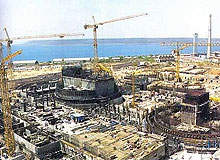
India has an installed capacity of 159,508MW with a nuclear capacity of 3,987MW. The country has 19 operating nuclear reactors, which are of pressurised heavy water reactor (PHWR) and boiling water reactor (BWR) types. The nuclear generation for 2009 was about 15bn kilo Watt hours (BkWh).
Nuclear Power Corporation of India (NPCIL) and Bharatiya Nabhikiya Vidyut Nigam are the key players in India’s nuclear power industry. The nuclear power contribution is about 2% of total electricity production. Presently, four reactors are under construction and 33 more are in the planning/proposal stages.

Discover B2B Marketing That Performs
Combine business intelligence and editorial excellence to reach engaged professionals across 36 leading media platforms.
The Atomic Energy Commission (AEC), the Department of Atomic Energy (DAE) and the Atomic Energy Regulatory Board (AERB) are the main regulatory bodies for nuclear energy in India. The country has abundant thorium reserves and plans to develop advanced reactor systems which utilise thorium as nuclear fuel.
Trends and developments
India plans to have 20GW of installed nuclear capacity by 2020, and 63GW by 2032. The country aims to generate 25% of its total electricity from nuclear energy by 2050. It plans to develop eight PHWRs, three fast-breeder reactors and one advanced heavy water reactor. It also has plans to construct six EPR units at Jaitapur, Maharashtra State, and carry out feasibility studies to build a Korean APR-1400 reactor.
India has a long-term plan to develop expertise in fast reactors and the thorium fuel cycle. The nuclear energy activities carried out by India with respect to self sufficiency comprise fuel exploration and mining, fuel fabrication, design and construction of reactors, reprocessing and waste management. The Nuclear Suppliers Group (NSG) agreement, signed in 2008, will aid the supply of fuel and reactors across the globe.
The growing demand for power, huge reliance on coal, oil imports, transportation of power and the well-established nuclear power industry have contributed to the development of nuclear power in the country.

US Tariffs are shifting - will you react or anticipate?
Don’t let policy changes catch you off guard. Stay proactive with real-time data and expert analysis.
By GlobalDataIndia is also planning to use the recovered plutonium from spent fuel to trial in the prototype fast breeder reactor (PFBR). It intends to develop a program for using its vast thorium reserves. The nuclear deal signed with the US in 2008 will help develop its nuclear capabilities and further provide a momentum to its future nuclear expansion plans.
Despite its nuclear capabilities, a shortage of uranium, the need for technological support and public concerns over the usage of nuclear development are some of the challenges the country needs to address. The trend in India is to develop advanced reactors using the thorium / plutonium fuel cycle.
It is also planning to import uranium from France, Kazakhstan, Brazil and South Africa, thus opening up new opportunities for fuel suppliers in the global nuclear power industry.





